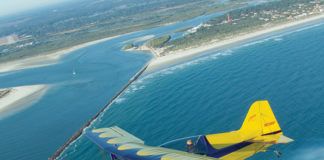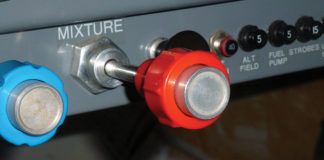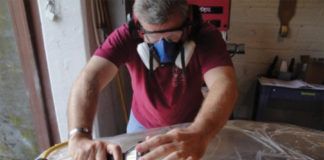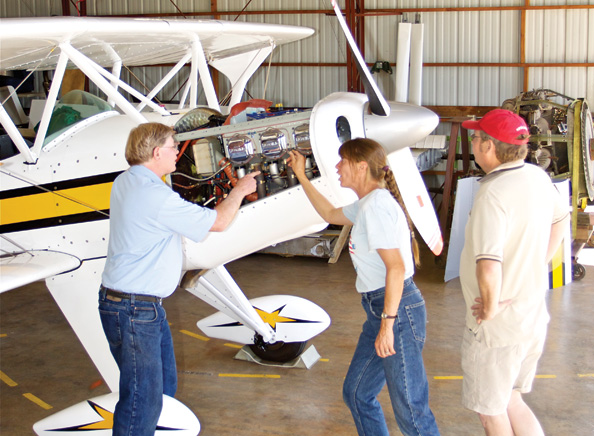
Lets say you’re looking for something to do in the hangar, something that wont cost much, something useful and that wont take forever. How about some simple chores to improve the safety of your airplane, many of which are items that might get overlooked even at annual condition inspection time?
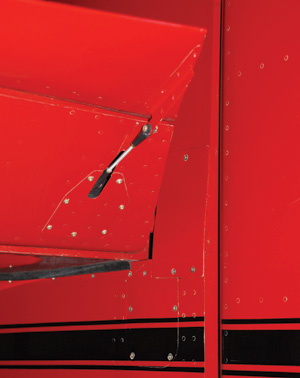
All screws present and accounted for, sir! And hopefully tight.
1. Wash the Plane by Hand
By hand? For safety? You’ve got to be kidding! Actually, no. Some years ago I applied to fly for Wings of Hope, and the overnight reading assignment was the flight operations manual. One of the requirements was for the pilot to wash the plane, by hand, once a week. The reason was that if you ran your hands over every inch of the plane and watched what you were doing, youd find small problems before they became big ones, such as missing screws that could lead to corrosion, lost or poorly secured access panels or fluid leaks. You might also find smoking rivets, i.e., rivets that are starting to come loose, chafing in the holes and resulting in black aluminum oxide that leaves a streak. My old RV-4 had a bunch of these where the firewall joins the fuselage. While the smokers on top of the wing, as an example, might be plenty obvious, washing the airplane gives you the opportunity to find those problem rivets in, shall we say, less exposed locations? Hint: Don’t subcontract cleaning the belly. Oh, and FAR 43 calls for a certificated airplane to be washed at annual time, probably not just for cleanliness.
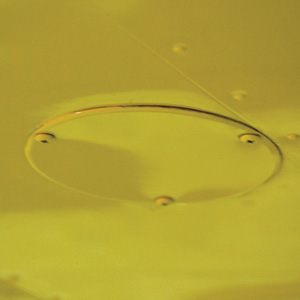
This access plate is in place and has all its screws, but are all of the screws snug?
2. Corroded Nuts and Bolts
The AirCam that I bought had apparently been parked outside in salt air, and the nuts and bolts on the wingstruts were all corroded. This obvious safety hazard was easily remedied by replacing the hardware. Quick, easy, and it made the plane look better, too. Just be sure you know what you’re replacing and go kind-for-kind. No hardware-store bolts where true AN (or NAS) hardware is called for.
3. Tighten Up
Get out your Phillips screwdriver and make sure all of the screws are snug, not overly tight, on all fairings and access panels. Then get your Allen wrenches and do the same for the set screws in the knobs on the instrument panel. Youd hate to lose use of a radio because the knob was playing footsie with the rudder pedals, and once a small piece falls into the bilge, how likely is it to ever be found again?
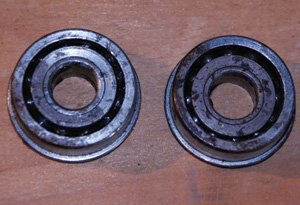
Tailwheel bearings are supposed to be symmetric like the one on the left, not worn so much that the center can wander like the one on the left.
4. Wheel Bearings
Its too easy to just slap some grease on a wheel bearing and call it good or, as was the case with the AirCam, to pump grease into the tailwheel through the fitting and never look at the bearing. If you’ve not taken the bearings completely out of the wheel and looked at them, get out the old clothes and the rags and do it. My AirCam had a tailwheel bearing that was well past worn out before it started causing trouble.
5. Tailwheel Steering
The AirCam had a tailwheel that was steerable but would pop free and swivel for sharper turns. At one annual, we inspected the tailwheel (due to other problems) and thats when we discovered that the swiveling feature was asymmetric: It would swivel one way much easier than the other. Turns out the locking key was fractured at one end. So while the tailwheel is up in the air, check it, take it apart, and clean all of the pieces.
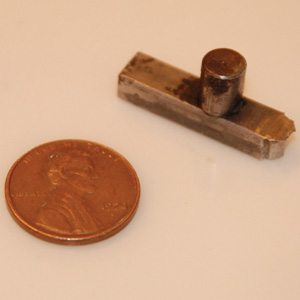
When this piece is symmetric, so is the tailwheel steering. When its not, you might be going for a ride.
6. Leaking Brake Fittings
For some reason, the brake fluid level in the AirCam was slowly going down, but the brakes worked fine and there were no indications of leaks. The problem was a slight leak through a bleed fitting that wasn’t completely tight. The brakes only leaked when pressure was applied, on runways and taxiways, and there were no drips in the hangar. Put some white paper under your brakes, get in the airplane, and stand hard on the brakes for 30 seconds. Then check for obvious drips, and also wipe the bleed fittings on the brake calipers for drops just starting. This is also a good reason to keep the wheels, brake calipers and wheel pants scrupulously clean. New leaks can be hiding under the muck, but they cant hide if there’s no muck.
7. Circuit Breaker and Switch Labels
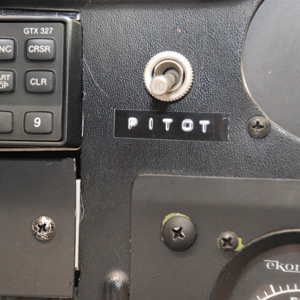
An inexpensive label maker and 2 minutes of effort will mean that everybody, not just the pilot, will know what this switch is for.
If you bought your airplane from somebody else, chances are better than 50/50 that the wiring has problems. On my AirCam, the factory wiring diagram called for a single 2-amp breaker to service all of the engine instruments. Instead, there were two breakers, one for each engine. The diagram also called for separate 5-amp breakers for the auxiliary fuel pumps. There was only one, and the labels on the breaker panel had little resemblance to how things were actually wired. Find out what devices are attached to what breakers (or fuses), and be prepared to use your label maker to set things right. Don’t forget a pad of paper and a camera. You can also use a spreadsheet as a way to keep track of bus bar connections. Every bit of documentation you commit makes somebodys life easier down the line.
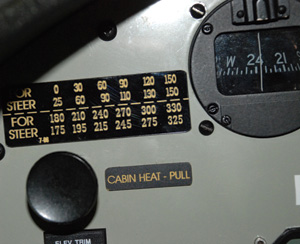
Its good to have a compass correction card, but look at the magnitude of the corrections! If you reswing the compass, you can probably do better than this.
8. Compass Not Swung
In this age of GPS, lots of us look at the magnetic compass and blow it off. It may not have a compass correction card, or maybe the correction card shows 20 or 30 errors on some headings. Get your non-magnetic screwdriver (or make one from a small piece of sheet aluminum), a pad of paper, and head over to your local compass rose. The procedure for swinging a compass is straightforward. With the engine running and all of the avionics on, align the aircraft with north on the compass rose. Set the N-S screw so that the compass reads north, dead on. Turn the aircraft to face east and check the indication; adjust the compass with the E-W screw to read 90. Now turn to the south and read the compass. If it doesn’t show 180, adjust the N-S screw to take out half of the needed correction. Continue to west; again, adjust the E-W screw for half the correction. Were almost done. Now turn around the compass rose again, stopping every 30. Note the difference between actual heading (via the compass rose) and the indication on the compass. Write it down. This is your noted deviation and should be on the compass correction card. If you’re really smart, you will be watching your EFISs magnetic indicator while you’re doing these steps to see how well it is aligned, and how smoothly it moves. You might also take this opportunity to try different electrical configurations to see if they have any influence on the indicated heading. If they do, find out why.
9. Spinner Backplate
Dont push on the propeller, were all told, but nobody ever said don’t push on the spinner, so unfortunately lots of folks do. Actually, its far worse to push on the spinner, because the spinner is usually screwed to the backplate, which looks like an overgrown pie pan. Pie pans are not for pushing, and with that big aluminum piece taking engine vibration firsthand, its easy for cracks to develop and the spinner to come loose. Trouble is, when it comes loose, its likely to gouge the prop and the airframe, both expensive to repair. Worse, whats left of the spinner may cause severe imbalance and vibration, which could be so bad that youd have to throttle back below power required for level flight.
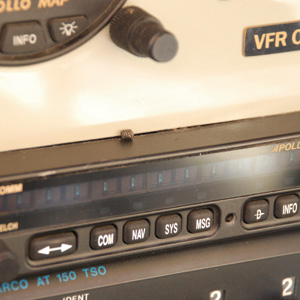
When a set screw falls out of a knob, don’t count on it to land where its visible, as this one did.
10. Exhaust System
When the engine is cold, rub your finger inside the exhaust pipe. If it comes back covered with soot, there’s a good chance your engine is running too rich, or may be burning oil. Soot is a good reason to check your spark plugs.
I did one takeoff in my old RV-4 where, just as there was no longer a chance of landing on the runway ahead, the engine sound changed and the power dropped dramatically. When I removed the cowl to see what had happened, the clang of the exhaust pipe on concrete told the story. This failure should not have been a surprise-for me or for you. Exhaust-system failures are serious business.
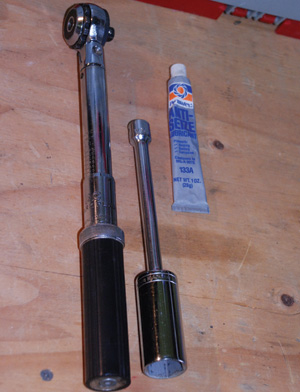
Checking spark plugs? Youll want a torque wrench, six-point spark plug socket and a tube of anti-seize.
11. Spark Plugs
When you want to feel like you’re doing real work on the plane, not that any of the other tasks arent, get out the anti-seize and the torque wrench and pull all the plugs. Check the color and deposits on the plugs (there are numerous guides on the web, including from Champion at www.championaerospace.com), and then clean and gap the plugs. Whenever I have done this on a O-360-A1A, there has been a noticeable increase in the engines smoothness. Those of us stingy with our time will combine the spark-plug check with an oil change and a compression check-you want the compression check while the engine is hot, which is also when the oil drains most readily and takes the greatest percentage of nasty contamination with it. Youll be removing the spark plugs to do the compression test, so do it all at once.
12. Simple Fuel-Gauge Check
On a landing approach, sometime in the traffic pattern, write down what the fuel gauges say. Then, at the fuel dock, write down again what the fuel gauges say. If you haven’t made a fuel dipstick yet, make one now, and mark the fuel level. Then fill the tank and mark the dipstick with how much fuel was in the tank (tank capacity minus fuel added is fuel in the tank). This will give you the fuel in the tank (for weight and balance purposes, depending upon how much fuel was in the tanks when weight and balance was performed) but not the usable fuel (for flight planning). Remember, its all about the level indications in flight.
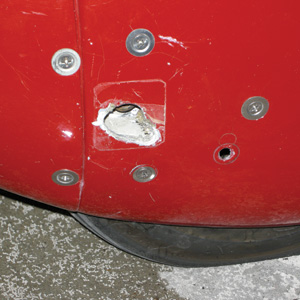
Torn fiberglass and missing screws. Is this something you knew about already?
13. Fuel Lines and Fittings
Have you ever smelled fuel in the cockpit when you werent expecting it? Why not take off the fairings and access plates, and check all the fittings? A hidden gotcha might be at work: Aircraft fittings are flared to 37 degrees, but industrial pipe fittings are flared to 45 degrees. Or it might be the case that the builder didn’t know any better and used the wrong flare tool-though its more likely he used the right flare tool incorrectly. (Hand making flares is as much art and science; few builders do it right the first time.) Look for any blue dye from the fuel that may be on a fitting or that may have dripped. If you found any dark colored stains when you washed the plane, this might also indicate a fuel leak. Fix it. Now.
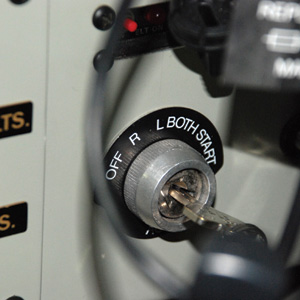
Regularly check your ignition switch to make sure it will kill both magnetos. Just because it works individually, as you may have seen during the runup, that doesn’t guarantee OFF is really OFF.
14. Hot Mag Check
Every time you do a conventional engine runup, you probably check that each magneto (or side of the ignition system) is capable of sustaining combustion. If you’re really smart, you’re looking for both a drop in engine rpm and a rise in all the cylinders EGT (exhaust gas temperature). When this happens, you at least know that when you place the key in the R position that the L (left) magneto or ignition is disabled. Same the other way around. But do you truly know if the OFF position is really OFF?
The only way to know is to perform a periodic hot shutdown check on the ignition. Simple, really: At the conclusion of the flight, switch off the engine using the key switch. If the engine continues to run, you obviously have a problem that needs immediate repair because the upshot is that the engine is hot all the time, and could start as you’re moving the propeller to fit the tow bar, as an example. Incidentally, when you run this test, just allow the engine to stop. Then, restart it normally, and shut it down with the mixture to ensure that fuel doesn’t get trapped in the injector lines. If the engine coughs and sputters with the key in the OFF position, immediately pull the mixture to force a shutdown.
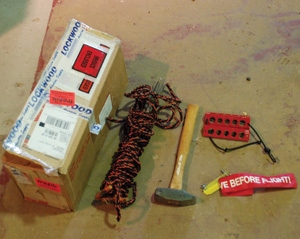
A tiedown kit in case you’re stuck overnight. Stakes and something to drive them in with (at an angle, so the taut rope is perpendicular to the stake), control locks as required and undersized chocks to fit under wheelpants.
15. Tiedown & Tool Kit
Lets say you find yourself out in the sticks and there are no tiedowns-leaving the airplane unsecured overnight is potentially quite unsafe. Thats why you should always have some ropes along, and a few pieces of wood that could serve as baby chocks. If you have metal stakes, make sure that you have a way to drive/screw them into the ground. Store-bought tiedown kits are fine but its worth checking the contents periodically to make sure you didn’t pinch a rope or break a tiedown stake. And don’t forget that when tiedown ropes are taut, they should be perpendicular to the stakes so that rope tension does not loosen the stake and pull it out.
As for tools, you should have a basic set including a good Phillips screwdriver with replaceable bits. A spare alternator belt for Lycoming-powered models will help buy you a bit of karma, too.










